The Thraupidae are a family of passerine birds found in the Americas. About 60% of tanagers live in South America, and 30% of these species live in the Andes. Most species are endemic to a relatively small area. In addition to "tanagers", dacnis, finches, flowerpiercers, honeycreepers, seedeaters, and many other diversely named species are included in Thraupidae. The tangara genus includes some of the most spectacularly colored THE WORLD BIRDS.
Tanagers are omnivorous, and their diets vary from genus to genus. They have been seen eating fruits, seeds, nectar, flower parts, and insects. Many pick insects off branches. Other species look for insects on the undersides of leaves. Yet others wait on branches until they see a flying insect and catch it in the air.
Some birds that are called Tanagers are actually in the Cardinal family Cardinalidae.
Genus Anisognathus
Found: South America
Tanager,_Black-cheeked_Mountain- also Santa Marta Mountain-Tanager Anisognathus melanogenys Found: Columbia
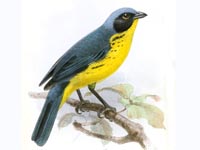
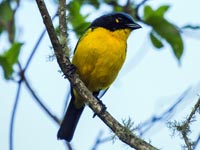
Tanager,_Black-chinned_Mountain- Anisognathus notabilis Found: west slope of the Andes of Colombia and Ecuador
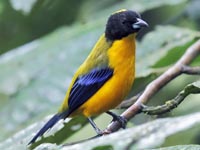
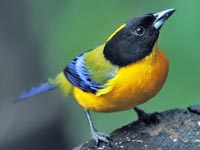

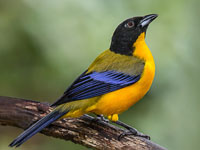
Tanager,_Blue-winged_Mountain- Anisognathus somptuosus Found: Andes from Columbia to Bolivia
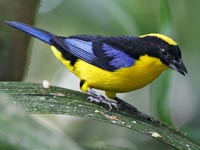
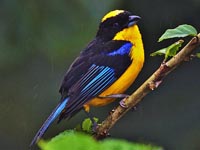
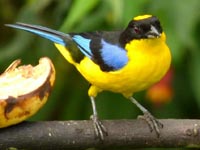
Tanager,_Lacrimose_Mountain- Anisognathus lacrymosus Found: Columbia, Ecuador, Peru, Venezuela
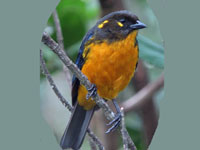

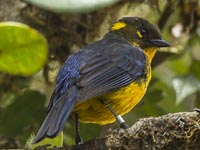
Tanager,_Scarlet-bellied_Mountain- Anisognathus igniventris Found: Bolivia, Colombia, Ecuador, Peru, Venezuela
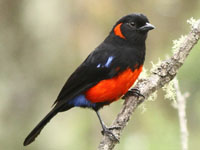
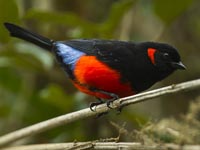
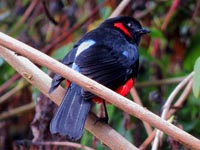
Genus Buthraupis
These two species of mountain-tangers are found in the Andean highlands of South America
Tanager,_Hooded_Mountain- Buthraupis montana Found: Andean highlands of Bolivia, Colombia, Ecuador, Peru, Venezuela
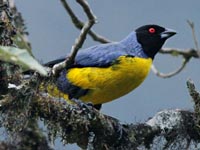
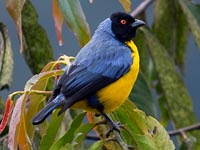
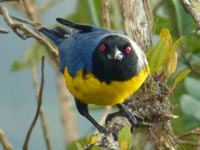
Tanager,_Masked_Mountain- Buthraupis wetmorei Found: Andean highlands of s. Colombia, Ecuador, n. Peru
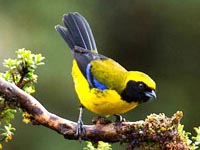
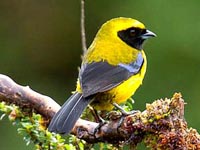
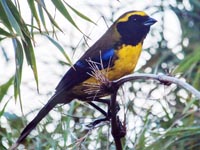
Genus Cnemathraupis
Tanager,_Black-chested_Mountain- Cnemathraupis eximia Found: Colombia, Ecuador, Peru, Venezuela
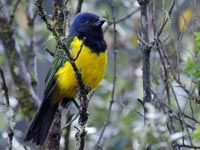
Tanager,_Golden-backed_Mountain- Cnemathraupis aureodorsalis Found: Peru
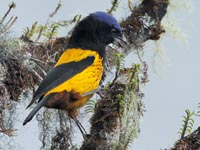
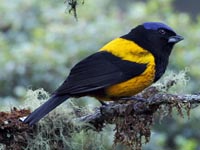
Genus Coereba - 1 species
Bananaquit Coereba flaveola Found: North America (Florida, but rarely), Caribbean, South America
1, 2) Juvenile 8) Black morph
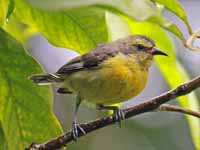

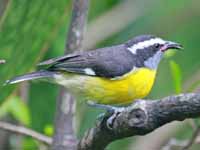
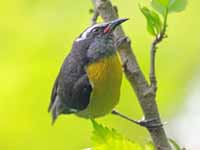
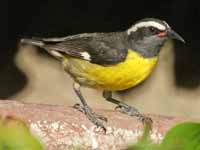

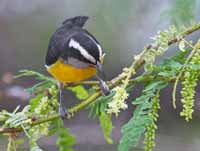

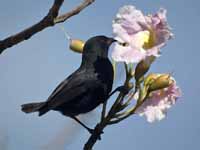
Genus Conirostrum
The conebills have a conical shaped bill!
Conebill, Bicolored Conirostrum bicolor Found: South America
1) Female 2, 3) Male
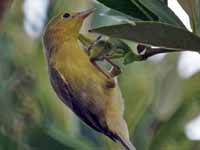


Conebill,_Blue-backed Conirostrum sitticolor Found: Bolivia, Colombia, Ecuador, Peru, Venezuela

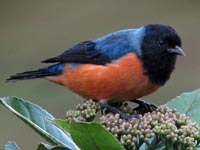
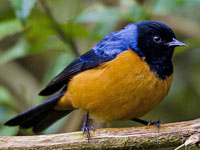
Conebill,_Capped Conirostrum albifrons Found: Bolivia, Colombia, Ecuador, Peru, Venezuela
1) Female 2, 3, 4) Male
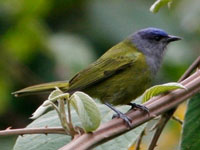
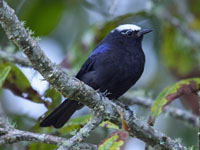
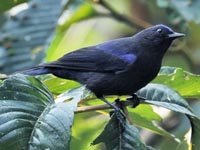
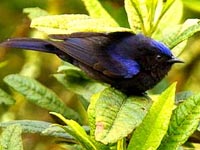
Conebill,_Chestnut-vented Conirostrum speciosum Found: South America
1. 2) Female 3, 4) Male
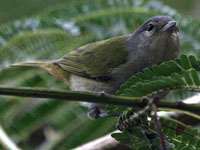
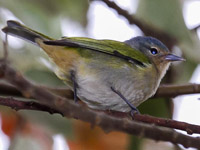
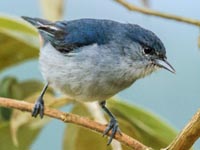

Conebill, Cinereous Conirostrum cinereum Found: South America (Andes)
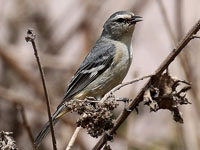



Conebill,_Giant Conirostrum binghami also Oreomanes fraseri Found: Colombia to Ecuador, and Peru to Bolivia


Conebill,_Rufous-browed Conirostrum rufum Found: mainly Columbia, also Venezuela
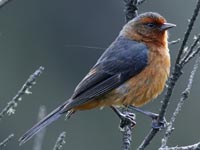
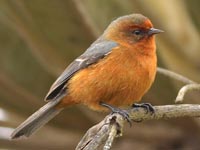
Conebill,_Tamarugo Conirostrum tamarugense Found: Chile, southern Peru
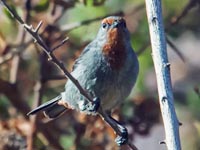

Conebill,_White-browed Conirostrum ferrugineiventre Found: Bolivia, Peru
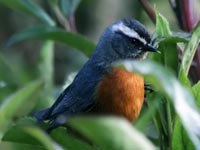

Genus Dubusia
Tanager,_Buff-breasted_Mountain- Dubusia taeniata Found: Columbia, Ecuador, Peru, Venezuela
1) D. t. taeniata 2) D. t. stictocephala
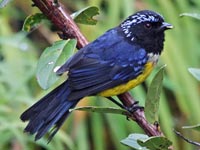
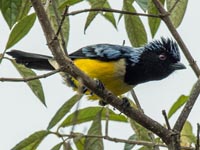
Genus Euneornis - 1 species
Orangequit Euneornis campestris Found: Jamaica
1, 2) Male 3, 4) Female
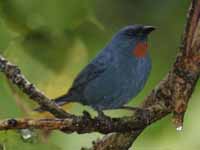
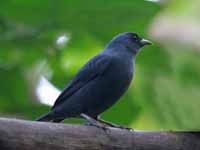
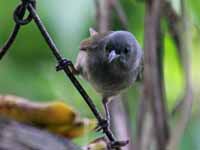
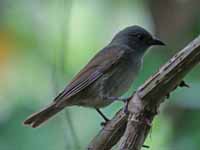
Genus Gubernatrix - 1 species
Cardinal,_Yellow Gubernatrix cristata Found: Argentina, Brazil, Paraguay, Uruguay
1) Pair 2) Female 3) Male

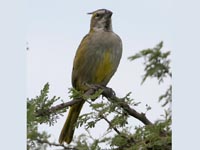
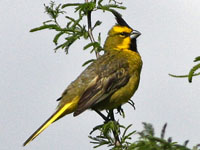
Genus Hemispingus
Hemispingus are found in the Andes.
Hemispingus,_Black-capped Hemispingus atropileus Found: Andes of Colombia, Ecuador, Peru, Venezuela
4) Subspecies H. a. auricularis found in Peru. May be separate species due to vocal difference.
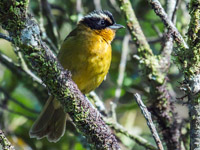
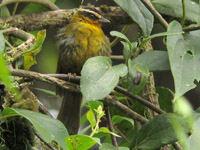
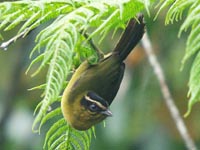
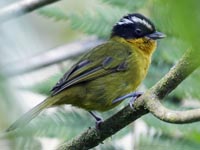
Hemispingus,_Black-eared Hemispingus melanotis Found: Bolivia, Columbia, Peru, Venezuela
1) H. m. piurae 3) H. m. ochraceus
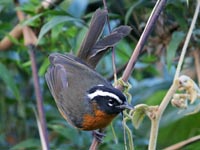
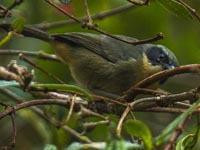
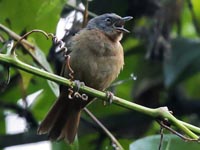
Hemispingus,_Black-headed Hemispingus verticalis also Pseudospingus verticalis Found: Colombia, Ecuador, Peru, Venezuela
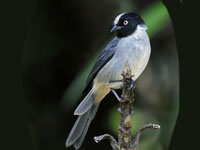
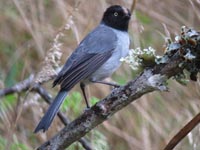
Hemispingus,_Drab Hemispingus xanthophthalmus also Pseudospingus xanthophthalmus Found: Bolivia, Peru

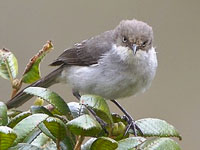
Hemispingus,_Gray-capped Hemispingus reyi also Kleinothraupis reyi Found: western Venezuela
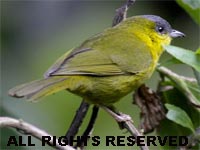
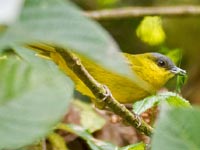
Hemispingus,_Oleaginous Sphenopsis frontalis also Hemispingus frontalis Found: Colombia, Ecuador, Peru, Venezuela
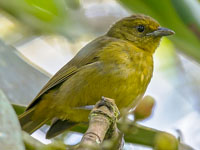
Hemispingus,_Orange-browed Hemispingus calophrys also Kleinothraupis calophrys Found: Boliva, southern Peru

Hemispingus, Parodi's Hemispingus parodii also Kleinothraupis parodii Found: Peru
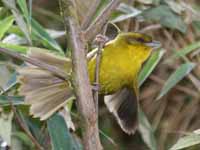
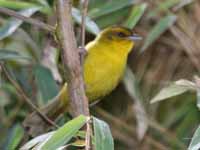
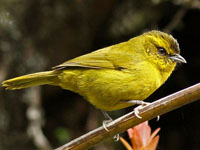
Hemispingus,_Rufous-browed Hemispingus rufosuperciliaris also Poospiza rufosuperciliaris Found: Peru

Hemispingus,_Slaty-backed Hemispingus goeringi also Poospiza goeringi Found: Venezuela
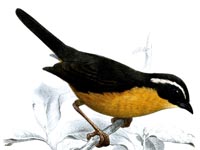
Hemispingus,_Superciliared Hemispingus superciliaris also Thlypopsis superciliaris Found: Bolivia, Colombia, Ecuador, Peru, Venezuela
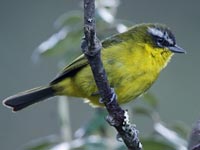
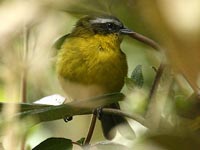
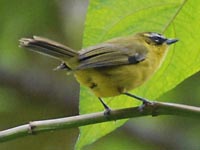
Genus Lanio
Tanager,_Black-throated_Shrike- Lanio aurantius Found: Mexico, Central America
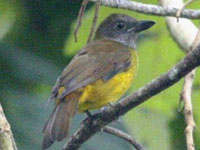
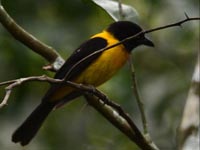
Tanager,_Fulvous_Shrike- Lanio fulvus Found: northern South America
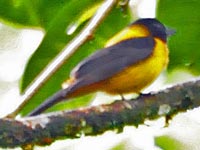

Tanager,_White-throated_Shrike- Lanio leucothorax Found: Central America
1) Female 2, 3) Male
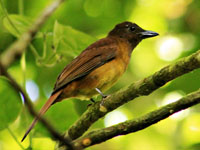
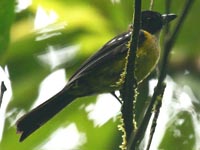
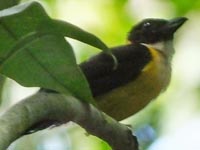
Tanager,_White-winged_Shrike- Lanio versicolor Found: Bolivia, Brazil, and Peru
1) Female 2, 3) Male
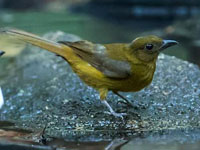
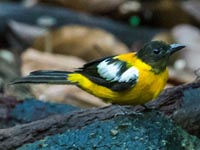
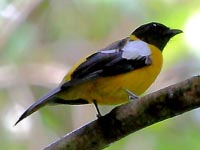
Genus Loxipasser - 1 species
Grassquit,_Yellow-shouldered Loxipasser anoxanthus Found: Jamaica
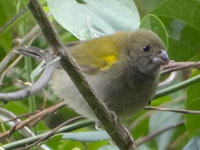
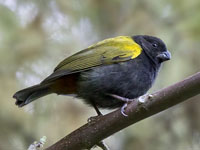
Genus Nephelornis - 1 species
Pardusco Nephelornis oneilli Found: central Peru
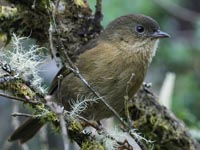
Genus Pseudosaltator - 1 species
Tanager,_Rufous-bellied_Mountain- Pseudosaltator rufiventris Found: Bolivia, Argentina
Image by: 1, 2) Nick_Athanas - Argentina
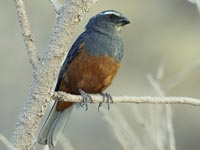
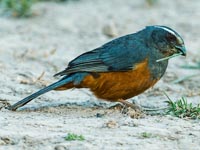
Genus Tiaris
Grassquit, Black-faced Tiaris bicolor Found: Caribbean and northern South America
1, 2, 3) Female 4 - 6) Male
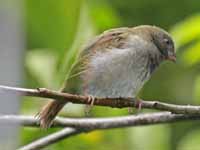

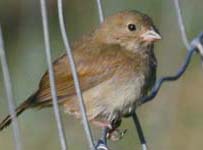
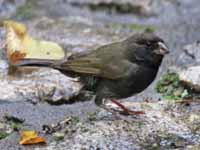

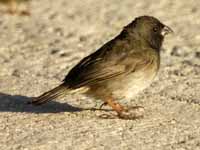

Grassquit,_Cuban Tiaris canorus Found: Cuban and other islands
1) Female 2, 3) Male
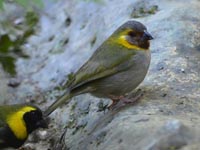
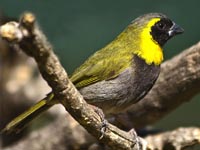
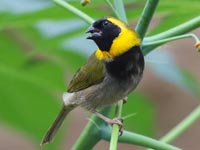
Grassquit,_Dull Tiaris obscurus Found: South America
3) Tiaris obscurus obscurus

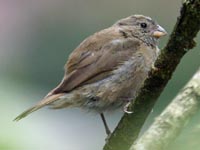
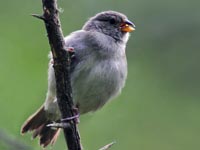
Grassquit,_Sooty Tiaris fuliginosus Found: South America
1) Female 2) Male

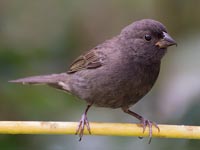
Grassquit, Yellow-faced Tiaris olivaceus Found: Central America
1, 2, 3) Female 4, 5, 6, 7) Male

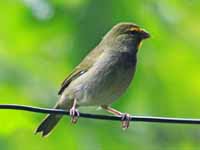
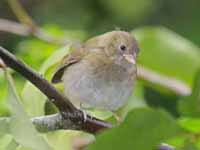
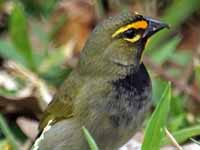
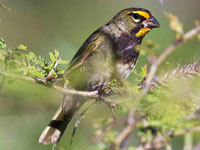

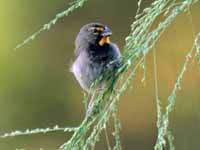
Genus Volatinia - 1 species
Grassquit,_Blue-black Volatinia jacarina Found: Central and South America
1 - 4 Female 5 - 8) Male
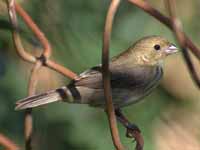


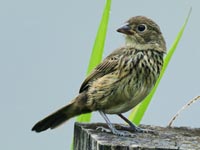
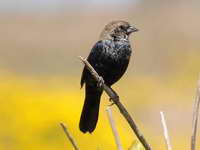

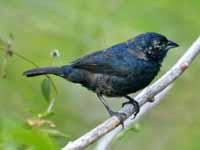
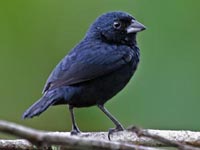
Tanagers are omnivorous, and their diets vary from genus to genus. They have been seen eating fruits, seeds, nectar, flower parts, and insects. Many pick insects off branches. Other species look for insects on the undersides of leaves. Yet others wait on branches until they see a flying insect and catch it in the air.
Some birds that are called Tanagers are actually in the Cardinal family Cardinalidae.
Genus Anisognathus
Found: South America
Tanager,_Black-cheeked_Mountain- also Santa Marta Mountain-Tanager Anisognathus melanogenys Found: Columbia
The Black-cheeked Mountain-Tanager has blue upperparts; large black ear-patch; yellow spot below eye; yellow underparts.
Image by: 1) John_Gerrard_Keulemans 2) Nick_Athanas - Columbia

Tanager,_Black-chinned_Mountain- Anisognathus notabilis Found: west slope of the Andes of Colombia and Ecuador
The Scarlet-bellied Mountain-Tanager has mainly yellow upperparts; black head with yellow rear crown; black chin; blue wings, tail.
Image by: 1, 2) Nick_Athanas - Ecuador 3) Ben_Tavener - Ecuador 4) Andy_Morffew - Ecuador



Tanager,_Blue-winged_Mountain- Anisognathus somptuosus Found: Andes from Columbia to Bolivia
The Blue-bellied Mountain-Tanager has mainly black upperparts; black head with yellow crown ;bright blue wings; yellow underparts.
Image by: 1) Nick_Athanas - Ecuador 2) Rafy_Rodriguez - Columbia 3) Alejandro_Tamayo


Tanager,_Lacrimose_Mountain- Anisognathus lacrymosus Found: Columbia, Ecuador, Peru, Venezuela
The Lacrimose Mountain-Tanager has blue upperparts, head (blackish on sides); yellow "teardrop" (hence name lacrimose) below eye; 2 yellow spots behid head.
Image by: 1) Félix Uribe - Columbia 2) José_Loaiza - Ecuador 3) Francesco_Veronesi - Columbia


Tanager,_Scarlet-bellied_Mountain- Anisognathus igniventris Found: Bolivia, Colombia, Ecuador, Peru, Venezuela
The Scarlet-bellied Mountain-Tanager has mainly black upperparts, head, breast; blue rump, wing-coverts; scarlet patch on ear coverts, belly.
Image by: 1) Mountain_Cornell_Univ's_Neotropical_Birds_Online - Luke_Seitz 2) Francesco_Veronesi - Ecuador 3) Jei_Pov - Columbia


Genus Buthraupis
These two species of mountain-tangers are found in the Andean highlands of South America
Tanager,_Hooded_Mountain- Buthraupis montana Found: Andean highlands of Bolivia, Colombia, Ecuador, Peru, Venezuela
The Hooded Mountain-Tanager has blue upperparts; black hood, legs; yellow underparts; red eyes.
Image by: 1) Nick_Athanas - Ecuador 2) Joao_Quental - Peru 3) Alejandro_Tamayo - Columbia


Tanager,_Masked_Mountain- Buthraupis wetmorei Found: Andean highlands of s. Colombia, Ecuador, n. Peru
The Masked Mountain-Tanager has mainly yellowish-green upperparts, nape, crown; large black masked trimmed with yellow; yellow underparts.
Image by: 1, 2) Francesco_Veronesi - Ecuador 3) Nick_Athanas - Ecuador


Genus Cnemathraupis
Tanager,_Black-chested_Mountain- Cnemathraupis eximia Found: Colombia, Ecuador, Peru, Venezuela
The Black-chested Mountain-Tanager has green upperparts has mainly black upperparts with gold band nin
Image by: 1) Nick_Athanas - Ecuador
Tanager,_Golden-backed_Mountain- Cnemathraupis aureodorsalis Found: Peru
The Golden-backed Mountain-Tanager has black upperparts with gold band mid-back; purplish-blue crown, shoulders; black throat; golden-yellow belly, rump,
Image by: 1, 2) Nick_Athanas - Peru

Genus Coereba - 1 species
Bananaquit Coereba flaveola Found: North America (Florida, but rarely), Caribbean, South America
The Banaquit has many subspecies and is variable in size and appearance. All have a curved bill which is used for obtaining nectar from flowers.
Image by: 1) Dick Daniels - Jamaica 2 , 3, 4) Dick - St. John, Virgin Islands 5, 9) New Jersy Birds 6, 7, 8) Dick - Puerto Rico 1, 2) Juvenile 8) Black morph









Genus Conirostrum
The conebills have a conical shaped bill!
Conebill, Bicolored Conirostrum bicolor Found: South America
The Bicolored Conebill has grayish-blue upperparts; buff underparts; pink legs. Its habitat is coastal mangrove swamps and neighboring woodlands.
Image by: 1, 2) New Jersy Birds 3) Ingeborg_van_Leeuwen - Brazil1) Female 2, 3) Male



Conebill,_Blue-backed Conirostrum sitticolor Found: Bolivia, Colombia, Ecuador, Peru, Venezuela
The Blue-backed Conebill has mainly bright blue upperparts; black head, wings, tail, bib; rufous-red underparts.
Image by: 1) Nick Athanas - Peru 2) Félix_Uribe - Columbia 3) Carlos_Henrique - Ecuador


Conebill,_Capped Conirostrum albifrons Found: Bolivia, Colombia, Ecuador, Peru, Venezuela
The male Capped Conebill has mainly black plumage; blue crown, rump, shoulder patch. A subspecies has a white crown. Female has mainly olive-green plumage; blue crown.
Image by: 1, 2) Cornell_Univ's_Neotropical_Birds_Online - Oscar_Johnson in Peru, Alonso_Quevedo_Gil in Columbia 3) Nick Athanas - Ecuador 4) Francesco_Veronesi - Ecuador1) Female 2, 3, 4) Male




Conebill,_Chestnut-vented Conirostrum speciosum Found: South America
The Chestnut-vented Conebill has blue-gray head; dark eye-line; pale underparts. Male has blue-gray upperparts; chestnut vent. Female has olive-green upperparts.
Image by: 1) Opisska - Brazil 3) Nick Athanas - Brazil 2, 4) Carlos_Henrique1. 2) Female 3, 4) Male




Conebill, Cinereous Conirostrum cinereum Found: South America (Andes)
The Cinereous has greenish-gray upperparts; darker crown; dark wings with white wingbar; light supercilium; buff-gray underparts. It is found in Bolivia, Chile, Colombia, Ecuador, and Peru. Its natural habitats are subtropical or tropical moist shrubland, subtropical or tropical high-altitude shrubland, and heavily degraded former forest.
Image by: 1) Brendan_Ryan - Chile 2, 3, 4) Dick Daniels - Ecuador 



Conebill,_Giant Conirostrum binghami also Oreomanes fraseri Found: Colombia to Ecuador, and Peru to Bolivia
The Giant Conebill has blue-gray upperparts; white cheek patch; chestnut underparts.
Image by: 1) Nick Athanas - Ecuador 2) Nigel_Voaden - Ecuador

Conebill,_Rufous-browed Conirostrum rufum Found: mainly Columbia, also Venezuela
The Rufous-browed Conebill has mainly bluish-gray upperparts; rufous forehead, supercilium, face, underparts.
Image by: 1) Nick Athanas - Columbia 2) Neil_Martinez

Conebill,_Tamarugo Conirostrum tamarugense Found: Chile, southern Peru
The Tamarugo Conebill has mainly gray plumage; rufous supercilium, forehead, throat, undertail-coverts.
Image by: 1) Nick Athanas - Chile 2) Cornell_Univ's_Neotropical_Birds_Online - Freddy_Olivares in Chile

Conebill,_White-browed Conirostrum ferrugineiventre Found: Bolivia, Peru
The White-browed Conebill has bluish-gray upperparts; head; white supercilium; furous underparts.
Image by: 1) Nick Athanas - Peru 2) Håkan_Sandin - Bolivia

Genus Dubusia
Tanager,_Buff-breasted_Mountain- Dubusia taeniata Found: Columbia, Ecuador, Peru, Venezuela
The Buff-breasted Mountain-Tanager has a buff breast-band.
Image by: 1, 2) Nick_Athanas - Ecuador, Peru1) D. t. taeniata 2) D. t. stictocephala


Genus Euneornis - 1 species
Orangequit Euneornis campestris Found: Jamaica
Its natural habitats are subtropical or tropical moist lowland forests and heavily degraded former forest.
Image by: 1, 2, 3, 4)
Dick Daniels - Jamaica1, 2) Male 3, 4) Female




Genus Gubernatrix - 1 species
Cardinal,_Yellow Gubernatrix cristata Found: Argentina, Brazil, Paraguay, Uruguay
The male Yellow Cardinal has mainly yellow plumage; yellow supercilium, malar stripe; black crest, throat patch. Female similar; white facial stripes; gray breast, flanks; yellow center of belly.
Image by: 1) Alder_Vasquez 2) Lip_kee - Argentina 3) Ron_Knight1) Pair 2) Female 3) Male



Genus Hemispingus
Hemispingus are found in the Andes.
Hemispingus,_Black-capped Hemispingus atropileus Found: Andes of Colombia, Ecuador, Peru, Venezuela
The Black-capped Hemispingus has green upperparts; black head; whitish supercilium; yellow underparts.
Image by: 1, 4) Nick_Athanas - Ecuador. Peru 2) Diego Calderon - Columbia 3) Dave_Curtis - Columbia4) Subspecies H. a. auricularis found in Peru. May be separate species due to vocal difference.




Hemispingus,_Black-eared Hemispingus melanotis Found: Bolivia, Columbia, Peru, Venezuela
The Black-eared Hemispingus black cheeks; pale supercilium; cinnamon to rufous underparts.
Image by: 1, 3) Nick_Athanas 2) Francesco_Veronesi1) H. m. piurae 3) H. m. ochraceus



Hemispingus,_Black-headed Hemispingus verticalis also Pseudospingus verticalis Found: Colombia, Ecuador, Peru, Venezuela
The Black-headed Hemispingus has gray upperparts; black head with whitish median stripe; white underparts; pale eyes.
Image by: 1) Nick_Athanas - Ecuador 2) Félix_Uribe

Hemispingus,_Drab Hemispingus xanthophthalmus also Pseudospingus xanthophthalmus Found: Bolivia, Peru
The Darb Hemispingus has gray upperparts; darker cheeks; white underparts.
Image by: 1, 2) Cornell_Univ's_Neotropical_Birds_Online - Daniel_Lane in Peru, Glenn Bartley in Peru

Hemispingus,_Gray-capped Hemispingus reyi also Kleinothraupis reyi Found: western Venezuela
The Gray-capped Hemispingus has olive upperparts; gray cap; yellow underparts.
Image by: 1) Karla Pérez 2) Fernando_Flores

Hemispingus,_Oleaginous Sphenopsis frontalis also Hemispingus frontalis Found: Colombia, Ecuador, Peru, Venezuela
The Oleaginous Hemispingus has olive-green upperparts; dull yellow underparts; faint yellow supercilium
Image by: 1) Cornell_Univ's_Neotropical_Birds_Online - Juan_Arango in Venezuela
Hemispingus,_Orange-browed Hemispingus calophrys also Kleinothraupis calophrys Found: Boliva, southern Peru
The Orange-browed Hemispingus black median crown stripe; broad orange supercilium; black eye-line.
Image by: 1) Cornell_Univ's_Neotropical_Birds_Online - Ian_Davies in Bolivia
Hemispingus, Parodi's Hemispingus parodii also Kleinothraupis parodii Found: Peru
The Parodi's Hemispingus has greenish-yellow plumage; green supercilium. Its natural habitat is subtropical or tropical moist high altitude forests.
Image by: 1, 2) Dominic
Sherony 3) Cornell_Univ's_Neotropical_Birds_Online - Luke_Seitz


Hemispingus,_Rufous-browed Hemispingus rufosuperciliaris also Poospiza rufosuperciliaris Found: Peru
The Rufous-browed Hemispingus has mainly slate-gray upperparts; black ear-coverts, median crown stripe; broad tawny supercilium; slightly tawny underparts.
Image by: 1) Nick_Athanas - Peru
Hemispingus,_Slaty-backed Hemispingus goeringi also Poospiza goeringi Found: Venezuela
The Slaty-backed Hemispingus has dark slaty-gray upperparts; black head with white superciliium; cinnamon-rufous underparts.
Image by: 1) Joseph_Smit
Hemispingus,_Superciliared Hemispingus superciliaris also Thlypopsis superciliaris Found: Bolivia, Colombia, Ecuador, Peru, Venezuela
The Superciliared Hemispingus has olive upperparts; dark cheeks; white superciliium; yellow underparts.
Image by: 1) Nick_Athanas - Ecuador 2) Michael_Woodruff - Ecuador 3) Carol_Foil - Peru


Genus Lanio
Tanager,_Black-throated_Shrike- Lanio aurantius Found: Mexico, Central America
The male Black-throated Shirke-Tanager has mainly yellow plumage; black hood, wings, tail. Female has olivie-green to brownish upperparts; olive-yellow underparts.
Image by: 1) Cornell_Univ's_Neotropical_Birds_Online - Sc0tt_Bower 2) Amado_Demesa

Tanager,_Fulvous_Shrike- Lanio fulvus Found: northern South America
The male Fulvous Shrike-Tanager has ochre-yellow mantle, underparts; black head, wings, tail; chesnut breast patch. Females mainly duller except brighter over rump.
Image by: 1) Jerry_Oldenettel - Venezuela 2) Cornell_Univ's_Neotropical_Birds_Online - Roger_Alhman

Tanager,_White-throated_Shrike- Lanio leucothorax Found: Central America
The male White-throated Shirke-Tanager has mainly yellow plumage; white throat; black head, wings, tail. Female has olivie-green upperparts; brownish throat; olive-yellow underparts.
Image by: 1) David_Rodríguez_Arias 2) Michael_Woodruff - Costa Rica 3) Barbara_Dye - Coast Rica1) Female 2, 3) Male



Tanager,_White-winged_Shrike- Lanio versicolor Found: Bolivia, Brazil, and Peru
The male White-winged Shike-Tanager has yellowish-olive upperparts; black wings with white patch; blackish tail; yellow underparts. Female similar to male with black is washed out.
Image by: 1, 2) Nick_Athanas - Brazil 3) Hector_Bottai - Brazil1) Female 2, 3) Male



Genus Loxipasser - 1 species
Grassquit,_Yellow-shouldered Loxipasser anoxanthus Found: Jamaica
The male Yellow-shouldered Grassquit has yellow upper-back, wings; black head, neck, upper-breast; paler over rest underparts.
Image by: 1, 2) Cornell_Univ's_Neotropical_Birds_Online - Catherine_McFadden, Sam_Woods

Genus Nephelornis - 1 species
Pardusco Nephelornis oneilli Found: central Peru
The Pardusco has olive-brown plumage; lighter underparts.
Image by: 1) Nick Athanas
Genus Pseudosaltator - 1 species
Tanager,_Rufous-bellied_Mountain- Pseudosaltator rufiventris Found: Bolivia, Argentina
Image by: 1, 2) Nick_Athanas - Argentina


Genus Tiaris
Grassquit, Black-faced Tiaris bicolor Found: Caribbean and northern South America
The male Black-face Grassquit has olive-green upperparts; black head, breast. Female and juvenile have olive-gray upperparts; pale gray underparts. It breeds in the West Indies and along the northern coasts of Colombia and Venezuela.
It feeds mainly on grass seeds.
Similar to: Blue-black Grassquit. Black-faced Grassquit has stouter bill. Female Blue-black Grassquit has streaked belly.
Image by: 1, 2, 4) Dick Daniels - Jamaica 3, 5) Dick - Puerto Rico 6, 7)
New Jersy BirdsSimilar to: Blue-black Grassquit. Black-faced Grassquit has stouter bill. Female Blue-black Grassquit has streaked belly.
1, 2, 3) Female 4 - 6) Male







Grassquit,_Cuban Tiaris canorus Found: Cuban and other islands
The male Cuban Grassquit has black mask, breast patch; orange-yellow partial hood; gray crown, belly. Female has similar pattern but washed out.
Image by: 1) Ekaterina_Chernetsova 2) Richard_Taylor 3) Mario_Madrona1) Female 2, 3) Male



Grassquit,_Dull Tiaris obscurus Found: South America
The Dull Grassquit has plain brown plumage; lighter underparts. There is also a gray colored race: Tiaris obscurus obscurus.
Image by: 1, 3) Nick Athanas - Ecuador, Peru 2) Dominic_Sherony - Peru3) Tiaris obscurus obscurus



Grassquit,_Sooty Tiaris fuliginosus Found: South America
The male Sooty Grassquit has mainly gray plumage; blackish bill. Female has mainly olive-brown plumage.
Image by: 1) Cornell_Univ's_Neotropical_Birds_Online - Alison_Bentley 2) Dario Sanches1) Female 2) Male


Grassquit, Yellow-faced Tiaris olivaceus Found: Central America
The Yellow-faced Grassquit has olive-green upperparts; pale grayish-olive underparts. Male has bright yellow supercilium, eye-arc, throat. Female may have faint supercilium.
It feeds mainly on grass seeds.
Image by: 1, 2, 3, 7) Dick Daniels - Jamaica 4) New Jersy Birds 5) Mark_Peck 6) Dick - Boquette, Panama Mark_Peck1, 2, 3) Female 4, 5, 6, 7) Male







Genus Volatinia - 1 species
Grassquit,_Blue-black Volatinia jacarina Found: Central and South America
The male has blue-black plumage. Female has brown upperparts; dark-streaked buff underparts.
Similar to: Black-faced Grassquit. Black-faced Grassquit has stouter bill. Female Blue-black Grassquit has streaked belly.
Image by: 1) Dario Sanches - Brazil 2, 5)
Cláudio Timm - Rio Grande do
Sul, Brazil 3, 6) Dick Daniels - Panama, , Ecuador
7) New Jersy Birds 4, 8) Nick Athanas - ColumbiaSimilar to: Black-faced Grassquit. Black-faced Grassquit has stouter bill. Female Blue-black Grassquit has streaked belly.
1 - 4 Female 5 - 8) Male







